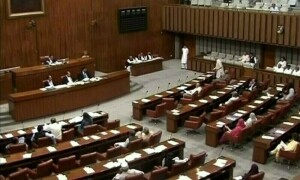''Corporate tax rate be lowered in fiscal year 2012 Budget'': Planning Commission Task Force recommendation
The Private Sector Development Task Force of Planning Commission has recommended reduction in the corporate tax rate in Budget 2011-12 with particular focus on challenges that remain to be addressed by the Federal Board of Revenue ie broadening of the tax base, documenting the informal sector, integration of domestic taxes, bringing GST into the VAT mode, streamlining regulations, and improvement in tax management and administration procedures.
The report of the task force issued on Monday, recommended that the corporate rates for all firms should be lowered starting in 2011-12 tax year. The amount of relief should be less than the increase in government revenues as a result of the broadening of the tax base and conversion of the general sales tax (GST) to the value added tax (VAT).
Task Force attaches great importance to bringing about macroeconomic stability to improve the level of public savings, which would result in increasing the tax-to-GDP ratio, which has gone down below 10 per cent in recent years. It is likely to fall below 9 percent in 2009-10. There is the need to reverse this trend and to build the capacity of the government to invest in public goods. The government can improve the quality of human resource available to the economy and also improve physical infrastructure if it has reasonable amount of resources.
While attempting to increase the tax-to- GDP ratio, the government should also lower the rate of corporate tax if the Pakistani firm is to become more competitive in the global market. Without increasing the tax base and without making the sources of income currently exempted from taxation or being subject to tax, any downward adjustment in corporate rates will result in decline of government revenue. The rationalisation of the tax base must therefore go hand in hand with increasing the tax-to-GDP ratio. In addition, rationalisation must also include a thorough review of the amount and nature of subsidies currently given to the operators in the various sectors of the economy. The government must pay attention to the following points:
It should adopt and announce in the budget a five year target for increasing tax to GDP ratio from the current 9.5 percent to 17 percent, increasing by 1.5 percentage points a year. According to the report, the Chairman of Federal Board of Revenue presented an overview of the functions, recent performance, reforms and challenges in tax revenue collection and tax administration.
The FBR is also responsible for implementing Trade Policy tariff related regulations. Despite FBR success in achieving revenue collection targets, the tax/GDP ratio in Pakistan has been declining and in 2007-8 it stood at 9.6 percent. Pakistan lags behind all the South Asian countries, except for Bangladesh in its tax/GDP ratio. Indirect taxes account for 61.6 percent of the total tax revenue, in contrast to more developed economies where a greater share of revenues comes from direct taxation.
The manufacturing and service sectors bear the brunt of taxation, while agriculture only accounts for 1.2 percent of total tax revenue. A low tax/GDP ratio is primarily the result of a narrow tax base due to exemptions and presence of a large informal sector. Weak audit, poor enforcement, and prevalence of corruption also act as significant barriers to improving tax collection.
The FBR is undertaking a variety of reforms to expand the tax base, increase compliance, rationalise tax rates, and create a "tax conducive" environment for all taxpayers. The FBR will be focusing on streamlining collection operations, systems improvement, better management practices, and IT based solutions to help achieve its reform objectives of greater efficiency and transparency in tax administration and collection.
The challenges that remain to be addressed include broadening of the tax base, documenting the informal sector, integration of domestic taxes, bringing GST into the VAT mode, streamlining regulations, and improvement in tax management and administration procedures.
Private Sector Development Task Force further recommended that trade policy review needs to be carried out over the next one year to analyse the impact of tariff, tax and exchange rate on exports. The government should also review the performance of the FTAs that are in place with a view to gauging their impact (i) on domestic industry and services, (ii) whether they resulted in trade diversion or trade creation, and what are the (iii) domestic implications of these agreements.
























Comments
Comments are closed.